Notes: In March 1847, Tweedmouth station opened at the northern end an isolated stretch of line from Chathill, and from 1 July that year trains operated from Newcastle. For just over a year Tweedmouth became the terminus of a main line route from London. Train services began on 29 August 1848 over a temporary bridge across the River Tweed enabling them to continue a mile north to join the North British Railway at Berwick station, thus completing a route from London to Edinburgh. The permanent Royal Border Bridge opened to freight on 20 July 1850, whilst the formal opening to passenger trains was performed by Queen Victoria on 29 August 1850. Passenger services had extended south-westwards beyond Tweedmouth on 27 July 1849 when the line to Sprouston opened, and it soon reached Kelso and St Boswells.
 The Newcastle & Berwick Railway stations were costly to construct and architecturally accomplished, and Tweedmouth was, by far, the most expensive and extravagant of them all. Yet Fawcett (2011) points out that it was a ‘quite needless’ station, only a mile from the North British station at Berwick. It was, in a sense, a statement as much as it was a station. In a display of truculence, George Hudson insisted on marking the northern outpost of his railway empire with a splendid station at Tweedmouth to equal, or outclass, the North British Railway’s Berwick station on the opposite side of the River Tweed; he would not be outdone by that company which had resisted his Newcastle & Berwick Railway’s overtures to take it over. Indeed the instructions to build an impressive station at Tweedmouth were given as late as 9 August 1847, long after the contracts had been let for other N&B station buildings, by which time it was clear that Hudson’s company would not own Berwick station. For the first year of its life timber buildings sufficed at Tweedmouth providing, as Fawcett notes, all of the necessary facilities at a terminus for the transhipment of passengers, parcels and mails. The Newcastle & Berwick Railway stations were costly to construct and architecturally accomplished, and Tweedmouth was, by far, the most expensive and extravagant of them all. Yet Fawcett (2011) points out that it was a ‘quite needless’ station, only a mile from the North British station at Berwick. It was, in a sense, a statement as much as it was a station. In a display of truculence, George Hudson insisted on marking the northern outpost of his railway empire with a splendid station at Tweedmouth to equal, or outclass, the North British Railway’s Berwick station on the opposite side of the River Tweed; he would not be outdone by that company which had resisted his Newcastle & Berwick Railway’s overtures to take it over. Indeed the instructions to build an impressive station at Tweedmouth were given as late as 9 August 1847, long after the contracts had been let for other N&B station buildings, by which time it was clear that Hudson’s company would not own Berwick station. For the first year of its life timber buildings sufficed at Tweedmouth providing, as Fawcett notes, all of the necessary facilities at a terminus for the transhipment of passengers, parcels and mails.
About the time that the elaborate stone buildings were completed, Tweedmouth station ceased to be a terminus, and thereafter it served as the junction for Kelso and St Boswells. It is ironic that no trace remains of Tweedmouth station, and the remarkably opulent castellated station built at Berwick was itself replaced in the 1920s by the London & North Eastern Railway with a more restrained design.
The unmerited splendour of Tweedmouth station, destined to life as a ‘secondary’ station in an urban area when its role as a terminus ceased, has a parallel in Sunderland: the even more magnificent Monkwearmouth ceased to be a terminus in the 1870s when the line it was on was extended into Sunderland and it became ‘a mere suburban station, stranded like some handsome ship in a breaker’s yard’ (Biddle 1973). Happily Monkwearmouth’s proud building is still with us.
The buildings at Tweedmouth, as with those of all of the other 1847-opened N&B stations (Cramlington excepted), were designed by Benjamin Green. The principal building cost £8,629 to construct, its closest rival in expenditure being Morpeth (£2,632), while a typical figure for the building at a wayside station would be £1,085 spent on Acklington – a dignified and commodious structure in private use at the station which is still open.
Tweedmouth station had two facing platforms separated by four railway tracks. It was considered sufficiently important to be given a trainshed formed of two steep, narrow spans. The station building containing office and waiting accommodation was on the down (south-west) platform. It was a lengthy, tall single-storey structure of sandstone ashlar, and its details were more Jacobean than Tudor, which set it apart from the other N&B station buildings. The gables at Tweedmouth were shaped, or ‘Dutch’, and two such gables surmounted the five-arched portico on the station forecourt. Ball finials capped these gables, as at other N&B stations, but elsewhere on the building some of the finials were of a hollow pyramidal design. Either side of the portico taller gabled sections projected from the façade, the north-western one with a canted bay, and the south-eastern with a mullioned window on the ground floor and a half-attic above. Tall chimneystacks rose above the steeply pitched Welsh slate roof. One of the trainshed roofs was attached to this building, and this and the other trainshed roof were supported by a row of columns midway between the platforms.
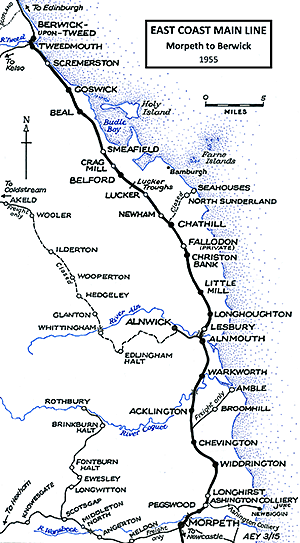 At the north-western end of the forecourt elevation was a two-storey block of striking appearance, set at right angles to the station buildings. This was the Station Hotel and refreshment rooms, generously decorated with Dutch gables, tall chimneys, and bay windows with deep parapets. Only the arrogance of Hudson could explain the provision of such lavish facilities for hospitality at what was soon to be a station of little importance. Fawcett suggests that part of this block might have been intended as the stationmaster’s house because no other accommodation was built for him. At the north-western end of the forecourt elevation was a two-storey block of striking appearance, set at right angles to the station buildings. This was the Station Hotel and refreshment rooms, generously decorated with Dutch gables, tall chimneys, and bay windows with deep parapets. Only the arrogance of Hudson could explain the provision of such lavish facilities for hospitality at what was soon to be a station of little importance. Fawcett suggests that part of this block might have been intended as the stationmaster’s house because no other accommodation was built for him.
The up platform was backed by a tall sandstone screen wall which originally supported one of the pitched roofs of the trainshed. A subway connected the slightly staggered platforms – the down platform extended further north-west than its opposite number.
Although as a passenger station Tweedmouth was not destined for greatness the location remained significant for over a century as a locomotive depot. To house the men working in the loco shed the N&B provided a terrace of 12 cottages in a style to complement the station buildings.
In 1850, a stone-built four-road locomotive shed with an attached workshop range was opened at Tweedmouth, on the down side of the tracks south-east of the passenger facilities. The shed was given a Gothic design to blend with the passenger station. Midway between the loco shed and the station was a goods warehouse, the largest on the Newcastle & Berwick Railway, and favoured with the customary Gothic features. In later years there were to be notable changes to the station’s goods and locomotive facilities.
The following timetable for May 1849 shows the services calling at Tweedmouth very early in its life as a through station, at the time when trains proceeded to and from Berwick, crossing the River Tweed by the temporary bridge which sufficed until the Royal Border Bridge was completed. The only train through Tweedmouth that did not stop was the first class-only 9.45am express from Edinburgh which called at Berwick, Lesbury (for Alnwick), Morpeth and Newcastle.
Up trains: weekdays |
Destination |
Down trains: weekdays |
Destination |
7.17am |
Newcastle |
9.43am |
Berwick |
10.47am |
Newcastle |
11.43am # |
Berwick |
1.17pm # |
Newcastle |
4.23pm |
Berwick |
5.32pm |
Newcastle |
6.38pm |
Berwick |
8.37pm |
Morpeth |
9.38pm |
Berwick |
Up trains: Sunday |
Destination |
Down trains: Sunday |
Destination |
7.02am |
Newcastle |
9.58am |
Berwick |
1.17pm # |
Newcastle |
11.34am # |
Berwick |
5.17pm |
Newcastle |
8.58pm |
Berwick |
8.37pm # |
Newcastle |
- |
- |
# Limited stop train
By February 1863 Tweedmouth Junction – as it was called in the timetable below – had ceased to be served by express trains. Only three up southbound weekday main line trains (one on Sunday) called at Tweedmouth, with four weekday (and one Sunday) departure in the opposite direction.
Up trains: weekdays |
Destination |
Down trains: weekdays |
Destination |
6.19am |
Newcastle |
8.11am (ex-Kelso) |
Berwick |
11.54am |
Newcastle |
8.50am (ex-Berwick) |
Kelso |
5.24pm |
Newcastle |
9.38am |
Berwick |
- |
- |
11.11am (ex-Kelso) |
Berwick |
- |
- |
12.00noon |
Berwick |
- |
- |
1.50pm (ex-Berwick) |
Kelso |
- |
- |
4.06pm (ex-Kelso) |
Berwick |
- |
- |
4.18pm |
Berwick |
- |
- |
4.30pm (ex-Berwick) |
Kelso |
- |
- |
7.10pm (ex-Berwick) |
Kelso |
- |
- |
8.06pm (ex-Kelso) |
Berwick |
- |
- |
9.35pm |
Berwick |
Up trains: Sunday |
Destination |
Down trains: Sunday |
Destination |
6.32am |
Newcastle |
7.05am (ex-Berwick) |
Kelso |
- |
- |
9.45am (ex-Kelso) |
Berwick |
- |
- |
4.35pm (ex-Berwick) |
Kelso |
- |
- |
8.17pm (ex-Kelso) |
Berwick |
- |
- |
9.18pm |
Berwick |
This timetable, and the others which follow on this page, is noticeably unbalanced in favour of ‘down’ departures. This curiosity arises from the role of Tweedmouth as the junction for, and reversal point of, trains in both directions between Berwick and Kelso. All ‘Kelso branch’ departures were in the down direction, whether going to Kelso, or to Berwick from Kelso, and the only up direction departures were those towards Newcastle on the main line. It is clear that by 1863 Tweedmouth had already lost its importance, and the Station Hotel provided at such expense could no longer be conveniently reached by long-distance travellers from the south, unless they were prepared to endure the rigours of an ‘all stops’ train journey from Newcastle, or retrace their steps from Berwick.
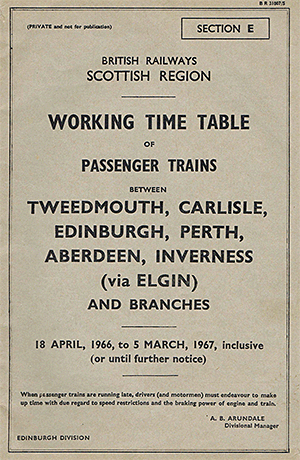 Whilst the importance of Tweedmouth as a passenger station was waning the accommodation for locomotives was increased in 1877-78 when the North Eastern Railway added a ‘square roundhouse’ with 20 roads radiating from one turntable. The addition was necessary as Tweedmouth was a changeover point for locomotives on stopping passenger trains and goods trains. Fawcett (2011) notes that Tweedmouth was sufficiently important to warrant a proper coaling stage, while increasingly thirsty engines were catered for by the construction of a reservoir and pumping station over a mile away at East Ord, from which water was piped alongside the Kelso branch. In 1902 the NER added further housing for enginemen in Howick Terrace and Falloden [sic] Terrace, designed by NER Chief Architect William Bell; the terraces were named after the two country seats of the Grey family whose influence on the original N&B (and the companies which later operated the ECML) is shown in the pages on Little Mill and Fallodon stations and extended into the LNER era. Whilst the importance of Tweedmouth as a passenger station was waning the accommodation for locomotives was increased in 1877-78 when the North Eastern Railway added a ‘square roundhouse’ with 20 roads radiating from one turntable. The addition was necessary as Tweedmouth was a changeover point for locomotives on stopping passenger trains and goods trains. Fawcett (2011) notes that Tweedmouth was sufficiently important to warrant a proper coaling stage, while increasingly thirsty engines were catered for by the construction of a reservoir and pumping station over a mile away at East Ord, from which water was piped alongside the Kelso branch. In 1902 the NER added further housing for enginemen in Howick Terrace and Falloden [sic] Terrace, designed by NER Chief Architect William Bell; the terraces were named after the two country seats of the Grey family whose influence on the original N&B (and the companies which later operated the ECML) is shown in the pages on Little Mill and Fallodon stations and extended into the LNER era.
Two signal boxes were provided at Tweedmouth. Named Tweedmouth ‘North’ and ‘South’ they were both in operation by 1873. North box, on the up side, was an N1 design in brick, while the South box was an N2 design, again in brick, with an N4 roof. Both boxes were used until 1961 when the new ‘Tweedmouth’ box took over their duties.
In 1906 the appearance of Tweedmouth station was greatly altered when the twin-span trainshed was removed and glazed awnings with end-screens were installed in its place by the NER, presumably to reduce maintenance costs. The company also proposed to close the refreshment room, which could scarcely be justified as a necessary facility for the limited number of passengers using the station. However Fawcett (2011) remarks that its true utility was indicated by a petition by Tweedmouth enginemen not to close it. ‘Clearly’, he writes, ‘it was a valuable adjunct to the shed, though of little use to anyone else’ and it remained in use at least until World War I.
Tweedmouth was a busy goods station which acted as a railhead for the agriculturally prosperous Merse area of Tweeddale and as a transfer point. Its facilities enabled a wide range of goods to be handled, and a 7-ton yard crane was provided. The Railway Clearing House Handbook of stations (1904) also adds a list of sidings supervised by Tweedmouth, as undernoted:
Allan Bros’ Siding
Dixon, J & Co’s Siding
Scremerston Colliery (between Tweedmouth and Scremerston)
Short, H O & Sons’ Siding
Tweed Dock
West Ord Siding (between Tweedmouth and Velvet Hall on the Kelso branch)
Hoole (1985) lists the principal goods handled in 1913 as manure (5,852 tons), timber (5,138 tons), oil cake (3,603 tons), grain (2,563 tons) and livestock (1,029 vans dispatched).
Despite its limited role as a calling point for local stopping (and reversing) trains, and serving a population of only 3,631 in 1911, Tweedmouth booked a respectable 29,125 tickets. The frequency of trains was probably at its peak at this time, shortly before World War I. The winter 1912-13 timetable for Tweedmouth is as follows:
Up trains: weekdays |
Destination |
Down trains: weekdays |
Destination |
6.49am |
Alnwick |
6.25am ¶ |
Coldstream |
7.41am |
Alnwick |
8.00am (Mon only) $ ¶ |
Coldstream |
9.19am |
Alnwick |
8.33am # |
Berwick |
10.57am |
Alnwick |
8.36am (ex-Kelso) |
Berwick |
1.42pm |
Alnmouth |
8.45am ¶ |
Kelso |
2.24pm (Sat only) |
Alnmouth |
10.40am (Fri only) ¶ |
Kelso |
3.26pm (Sat only) |
Alnmouth |
10.46am (ex-Kelso) |
Berwick |
5.24pm |
Alnmouth |
11.27am |
Berwick |
8.09pm |
Newcastle |
11.40am ¶ |
Kelso |
- |
- |
1.25pm |
Berwick |
- |
- |
1.33pm (ex-Kelso) |
Berwick |
- |
- |
2.20pm ¶ |
Kelso |
- |
- |
2.27pm (Sat only) |
Berwick |
- |
- |
2.55pm (Mon & Sat) ¶ |
Coldstream |
- |
- |
2.58pm (Fri only) * |
Berwick |
- |
- |
3.15pm (Sat only) ¶ |
Kelso |
- |
- |
4.11pm (ex-Kelso) |
Berwick |
- |
- |
4.29pm |
Berwick |
- |
- |
(5.18pm Sat only) * |
Terminates here |
- |
- |
5.44pm # |
Berwick |
- |
- |
5.52pm ¶ |
Kelso |
- |
- |
6.07pm (Sat only) |
Berwick |
- |
- |
7.29pm (Mon & Sat) ‡ |
Berwick |
- |
- |
8.28pm (ex-Kelso) |
Berwick |
- |
- |
8.38pm ¶ |
Kelso |
- |
- |
(9.13pm ex-Kelso) |
Terminates here |
- |
- |
9.59pm |
Berwick |
Up trains: Sunday |
Destination |
Down trains: Sunday |
Destination |
6.24am |
Newcastle |
8.29am # |
Berwick |
5.54pm |
Newcastle |
8.33am ¶ |
Kelso |
- |
- |
10.23am (ex-Kelso) |
Berwick |
- |
- |
10.55am |
Berwick |
- |
- |
6.08pm ¶ |
Kelso |
- |
- |
8.36pm (ex-Kelso) |
Berwick |
- |
- |
9.22pm |
Berwick |
$ Runs on alternate weeks (Monday only) # Limited stop train * ex-Kelso ‡ ex-Coldstream ¶ ex-Berwick Trains shown without a symbol are routed on the ECML south of Tweedmouth
By the later years of the North Eastern Railway, Tweedmouth’s goods and locomotive facilities had expanded greatly. Early in the twentieth century the NER had reorganised the layout to provide more space for the locomotive department. In 1907 the original goods warehouse had been converted into an engine repair shop whilst – as mentioned earlier – the original 4-road engine shed had been joined by a larger locomotive roundhouse in 1877-78. These buildings were all on the down side of the main line and south-east of the passenger station. On the up side numerous sidings fanned out, and a new goods warehouse had been constructed in 1902-03, much larger than its predecessor. A reversal from these sidings gave access to the Tweed Dock Branch. Over 50 engines were stabled at Tweedmouth in the 1920s.
 The arrangements for reversing the Berwick-Kelso/St Boswells trains at Tweedmouth deserve mention. The Kelso/St Boswells trains had to reverse when travelling in either direction and only the down platform of Tweedmouth – where the passenger facilities were located - was used. Trains from Kelso entered the station on the down platform and the loco ran round the train to haul it to Berwick. Trains from Berwick ran through the station on the up line to a point level with the engine shed and propelled the train back into the down platform; it then ran round its train, recoupled and set off north-westwards onto the branch. This procedure was necessary because the only lockable points were south of the station. The arrangements for reversing the Berwick-Kelso/St Boswells trains at Tweedmouth deserve mention. The Kelso/St Boswells trains had to reverse when travelling in either direction and only the down platform of Tweedmouth – where the passenger facilities were located - was used. Trains from Kelso entered the station on the down platform and the loco ran round the train to haul it to Berwick. Trains from Berwick ran through the station on the up line to a point level with the engine shed and propelled the train back into the down platform; it then ran round its train, recoupled and set off north-westwards onto the branch. This procedure was necessary because the only lockable points were south of the station.
The NER was one of the companies whose assets became part of the new London & North Eastern Railway in January 1923. The LNER identified needless duplication in the ex-North British Railway loco shed at Berwick one mile from the ex-NER shed at Tweedmouth; the 21 locos from Berwick were re-housed at Tweedmouth in August 1924. At Berwick the loss of the shed was accompanied by a remodelling of the tracks and wholesale reconstruction of the passenger station, which was completed in 1927.
Between the wars Tweedmouth continued to decline in importance as a passenger station and by the early 1930s it ceased to have its own stationmaster, coming under the supervision of Berwick. On the motive power front, in March 1939 Tweedmouth shed lost half of its stock when Berwick marshalling yard closed. An implication of this is that locomotives were no longer swapped at Tweedmouth, but crews continued to change here. The LNER left evidence of its ownership in the form of its standard running-in (and running-out) nameboards, with metal letters pegged to the wooden board.
Train departures from Tweedmouth in winter 1937-38:
Up trains: weekdays |
Destination |
Down trains: weekdays |
Destination |
7.26am |
Alnwick |
7.38am |
Coldstream |
8.37am |
Alnmouth |
8.40am ‡ |
Berwick |
1.31pm |
Newcastle |
8.53am § |
Kelso |
3.21pm |
Alnmouth |
8.59am (starts here) |
Berwick |
4.09pm # |
Newcastle |
10.52am (ex-Kelso) |
Berwick |
4.41pm |
Alnmouth |
11.25am |
Berwick |
5.31pm |
Newcastle |
11.37am |
Kelso |
- |
- |
2.06pm |
Kelso |
- |
- |
2.19pm |
Berwick |
- |
- |
3.28pm |
Berwick |
- |
- |
3.56pm (ex-Kelso) |
Berwick |
- |
- |
5.34pm (starts here) |
St Boswells via Kelso |
- |
- |
6.21pm |
Berwick |
- |
- |
7.33pm ¶ |
Berwick |
- |
- |
8.43pm |
Berwick |
- |
- |
9.30pm (Sat only) |
Sunilaws |
- |
- |
10.23pm (Sat only) † |
Berwick |
- |
- |
11.38 (Mon-Fri) |
Berwick |
- |
- |
12.56am (Sat only) |
Berwick |
Up trains: Sunday |
Destination |
Down trains: Sunday |
Destination |
6.19am |
Newcastle |
8.34am # |
Berwick |
5.39pm |
Newcastle |
10.30am |
Berwick |
- |
- |
8.58pm |
Berwick |
# Limited stop train ‡ ex-Coldstream § ex-Alnwick ¶ ex-St Boswells † ex-Sunilaws No Kelso branch trains on Sunday.
 Tweedmouth was placed within British Railways North Eastern Region in January 1948 when the railways were nationalised. Several months later the train operations at Tweedmouth were unexpectedly disrupted when, on 12 August, torrential rain in the Borders caused streams and rivers to swell and seven bridges on the main line between Berwick and Dunbar were washed out. Although there were landslides between St Boswells and Edinburgh, and one on the Tweedmouth-Kelso-St Boswells line, these were cleared within four days to enable ECML trains be diverted via Kelso between Tweedmouth and Edinburgh. The diversionary route was 15¾ miles longer than via Dunbar, and at first 90 minutes were added to the schedule – later reduced to just over an hour – but the alignment of the junction at Tweedmouth allowed through running without reversal, and on no fewer than 23 occasions the ‘Flying Scotsman’ completed its non-stop run of almost 409 miles between the capitals. Construction of temporary bridges allowed the main line to reopen by the end of October 1948, but diversions continued at weekends for the next year to enable permanent bridges to be built. Tweedmouth was placed within British Railways North Eastern Region in January 1948 when the railways were nationalised. Several months later the train operations at Tweedmouth were unexpectedly disrupted when, on 12 August, torrential rain in the Borders caused streams and rivers to swell and seven bridges on the main line between Berwick and Dunbar were washed out. Although there were landslides between St Boswells and Edinburgh, and one on the Tweedmouth-Kelso-St Boswells line, these were cleared within four days to enable ECML trains be diverted via Kelso between Tweedmouth and Edinburgh. The diversionary route was 15¾ miles longer than via Dunbar, and at first 90 minutes were added to the schedule – later reduced to just over an hour – but the alignment of the junction at Tweedmouth allowed through running without reversal, and on no fewer than 23 occasions the ‘Flying Scotsman’ completed its non-stop run of almost 409 miles between the capitals. Construction of temporary bridges allowed the main line to reopen by the end of October 1948, but diversions continued at weekends for the next year to enable permanent bridges to be built.
Under British Railways North Eastern Region management Tweedmouth passenger station continued its decline. In summer 1950 the frequency of departures had conspicuously reduced – as shown below - and trains had ceased to call on Sunday sometime between June 1949 and June 1950.
Up trains: weekdays |
Destination |
Down trains: weekdays |
Destination |
7.22am |
Newcastle |
6.40am |
St Boswells |
9.12am # |
Newcastle |
8.29am ¶ |
Berwick |
4.59pm |
Newcastle |
9.28am |
St Boswells |
8.49pm # |
Newcastle |
10.15am |
Berwick |
|
|
10.25am ¶ |
Berwick |
|
|
11.33am (Sat only) |
Coldstream |
|
|
1.45pm (Sat only) ‡ |
Berwick |
|
|
3.30pm |
St Boswells |
|
|
5.37pm ¶ |
Berwick |
|
|
6.26pm (Mon-Fri) |
Berwick |
|
|
6.33pm (Sat only) |
Berwick |
|
|
6.48pm |
St Boswells |
|
|
7.48pm (Mon-Fri) |
Berwick |
|
|
7.51pm (Sat only) |
Berwick |
|
|
8. 32pm ¶ |
Berwick |
|
|
9.50pm (Sat only) |
Coldstream |
# Limited stop train ¶ ex-St Boswells ‡ ex-Coldstream
 Although Tweedmouth was among the largest population centres on the main line in Northumberland (approximately 4,000) Berwick eclipsed it in importance. In 1951 only 1,957 tickets were issued at Tweedmouth. The Berwick-Kelso-St Boswells route suffered a rationalisation of its train services and stations in the 1955 after which there were only two trains each way on weekdays. By summer 1960 one local ‘main line’ passenger train in each direction called at Tweedmouth on weekdays, the poorest service of any Newcastle–Berwick station. With an average of only six passengers per train, the Berwick-St Boswells line was reportedly losing £58,000 per annum, and in 1962 the decision was made to close it to passengers, including Tweedmouth station. The Reshaping of British Railways (‘Beeching Report’) of March 1963 noted that it was a line already earmarked for closure, and this took place on Monday 15 June 1964, the final trains having called at Tweedmouth two days earlier. The passenger station at Tweedmouth was still intact in spring 1967 but it was demolished soon after. Although Tweedmouth was among the largest population centres on the main line in Northumberland (approximately 4,000) Berwick eclipsed it in importance. In 1951 only 1,957 tickets were issued at Tweedmouth. The Berwick-Kelso-St Boswells route suffered a rationalisation of its train services and stations in the 1955 after which there were only two trains each way on weekdays. By summer 1960 one local ‘main line’ passenger train in each direction called at Tweedmouth on weekdays, the poorest service of any Newcastle–Berwick station. With an average of only six passengers per train, the Berwick-St Boswells line was reportedly losing £58,000 per annum, and in 1962 the decision was made to close it to passengers, including Tweedmouth station. The Reshaping of British Railways (‘Beeching Report’) of March 1963 noted that it was a line already earmarked for closure, and this took place on Monday 15 June 1964, the final trains having called at Tweedmouth two days earlier. The passenger station at Tweedmouth was still intact in spring 1967 but it was demolished soon after.
In 1954 there were still 31 locomotives allocated to 52D, Tweedmouth shed, but the diesel era sealed its fate and it closed on 19 June 1966. The earlier four-road shed was demolished in 1968, but the later one still survives in industrial use as part of a builders’ merchants, although it suffered severe damage by fire on 14 January 2010.
 On 3 December 1961, shortly before the station’s demise, the old North and South signal boxes were replaced with one of sleek, flat-roofed design, and it is one of very few on the East Coast main line still in use. The new box was placed between the diverging main line and Kelso/St Boswells branch tracks, 73yd north of the former North box. Other boxes in this style appeared at that time at Belford and Tollerton further south on the ECML. On 3 December 1961, shortly before the station’s demise, the old North and South signal boxes were replaced with one of sleek, flat-roofed design, and it is one of very few on the East Coast main line still in use. The new box was placed between the diverging main line and Kelso/St Boswells branch tracks, 73yd north of the former North box. Other boxes in this style appeared at that time at Belford and Tollerton further south on the ECML.
Although goods facilities at Tweedmouth were closed in the 1980s the sidings were used in the preparations for electrification of the ECML which were completed in 1991. Three sidings still remain in place on the up side, parallel to the main line, through the site of Tweedmouth station.
The only structures related to the station which remain in 2015 are the 1877-78 engine shed, the two 1902 terraces of railwaymen’s cottages and the 1961 signal box.
Click here for a brief history of the East Coast Main Line
in Northumberland.
Route maps drawn by Alan Young
BIBLIOGRAPHY:
- Addyman, John F (Editor) A history of the Newcastle & Berwick Railway (North Eastern Railway Association, 2011) – especially Chapter 5 ‘The buildings’ by Bill Fawcett, and Chapter 7 ‘The Kelso Branch’ by Christopher Dean
- Biddle, Gordon Victorian stations (David & Charles, 1973)
- Fawcett, Bill A history of North Eastern Railway architecture Vol 1: The Pioneers (North Eastern Railway Association 2001)
- Darsley, Roger and Lovett, Dennis Berwick to St Boswells via Kelso (Middleton Press 2015)
- Young, Alan Railways in Northumberland (Martin Bairstow, 2003)
- Young, Alan Lost stations in Northumberland & Durham (Silver Link Publishing 2011)
- Eastern Railway Association 2001) and Vol 3: Bell and beyond (North Eastern Railway Association, 2005)
- Hoole, K Railway stations of the North East (David & Charles 1985)
- Quick, Michael Railway passenger stations in Great Britain: a chronology (RCTS 2009)
- Clinker, C R Clinker’s register of closed passenger stations and goods depots (Avon Anglia 1978)
- Dow, G ‘Deluge over the Border’ in Railway World (September-November 1968)
See other ECML stations:
Scremerston, Goswick, Beal, Smeafield, Crag Mill, Belford, Lucker, Newham, Fallodon, Christon Bank, Little Mill, Longhoughton, Lesbury, Warkworth, Longhirst, Ashington Colliery Junction, Morpeth, Stannington, Plessey, Annitsford (1st), Annitsford (2nd), Killingworth, Forest Hall, Heaton (2nd), Heaton (1st), Durham, Croft Spa, Eryholme, Otterington, Alne & Tollerton |

old51.jpg)

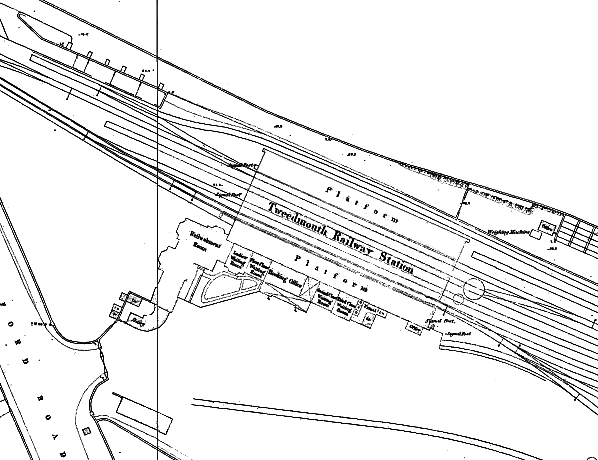
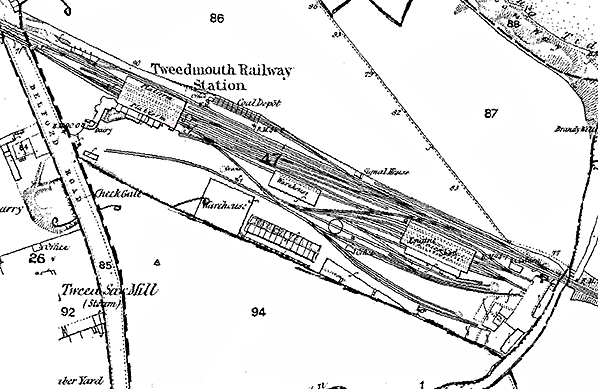
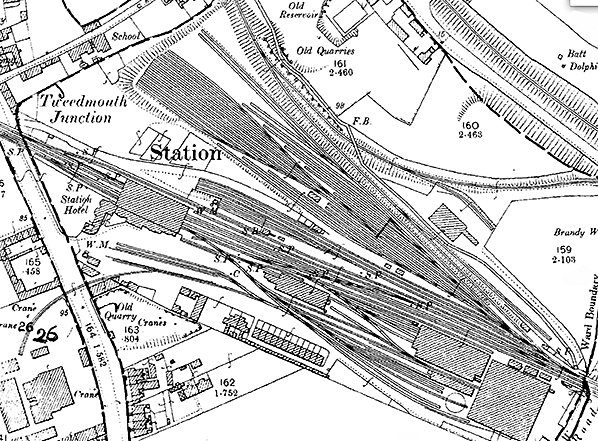
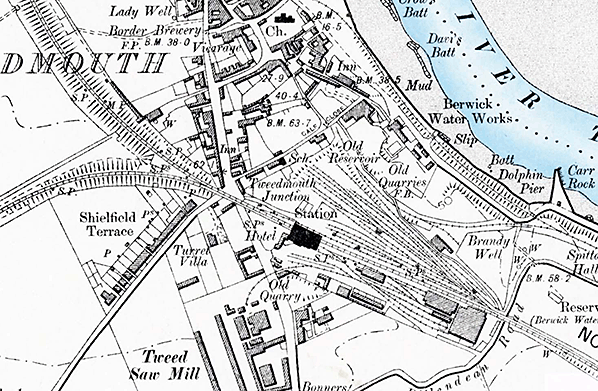
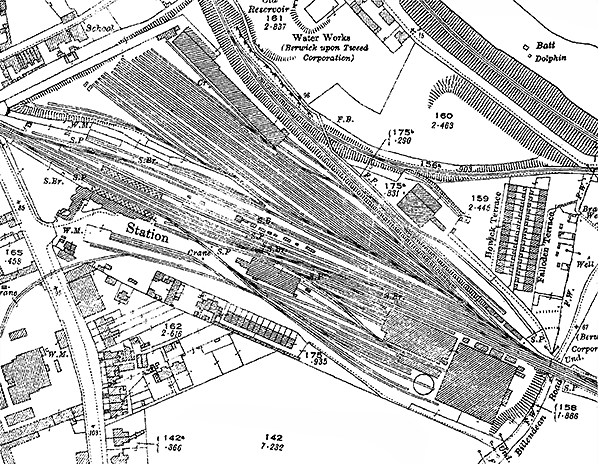
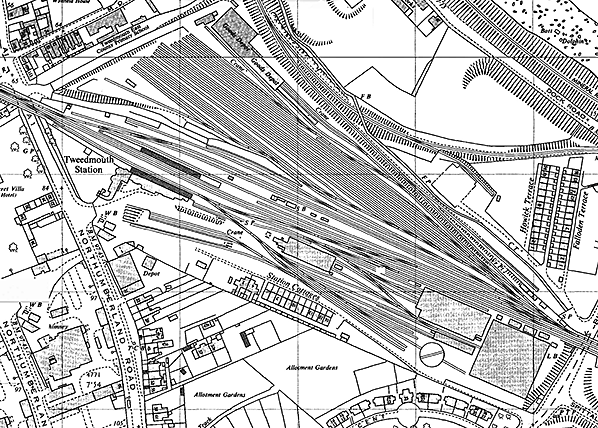
old5.jpg)
old13.jpg)
old11.jpg)
 The Newcastle & Berwick Railway stations were costly to construct and architecturally accomplished, and Tweedmouth was, by far, the most expensive and extravagant of them all. Yet Fawcett (2011) points out that it was a ‘quite needless’ station, only a mile from the North British station at Berwick. It was, in a sense, a statement as much as it was a station. In a display of truculence, George Hudson insisted on marking the northern outpost of his railway empire with a splendid station at Tweedmouth to equal, or outclass, the North British Railway’s Berwick station on the opposite side of the River Tweed; he would not be outdone by that company which had resisted his Newcastle & Berwick Railway’s overtures to take it over. Indeed the instructions to build an impressive station at Tweedmouth were given as late as 9 August 1847, long after the contracts had been let for other N&B station buildings, by which time it was clear that Hudson’s company would not own Berwick station. For the first year of its life timber buildings sufficed at Tweedmouth providing, as Fawcett notes, all of the necessary facilities at a terminus for the transhipment of passengers, parcels and mails.
The Newcastle & Berwick Railway stations were costly to construct and architecturally accomplished, and Tweedmouth was, by far, the most expensive and extravagant of them all. Yet Fawcett (2011) points out that it was a ‘quite needless’ station, only a mile from the North British station at Berwick. It was, in a sense, a statement as much as it was a station. In a display of truculence, George Hudson insisted on marking the northern outpost of his railway empire with a splendid station at Tweedmouth to equal, or outclass, the North British Railway’s Berwick station on the opposite side of the River Tweed; he would not be outdone by that company which had resisted his Newcastle & Berwick Railway’s overtures to take it over. Indeed the instructions to build an impressive station at Tweedmouth were given as late as 9 August 1847, long after the contracts had been let for other N&B station buildings, by which time it was clear that Hudson’s company would not own Berwick station. For the first year of its life timber buildings sufficed at Tweedmouth providing, as Fawcett notes, all of the necessary facilities at a terminus for the transhipment of passengers, parcels and mails. At the north-western end of the forecourt elevation was a two-storey block of striking appearance, set at right angles to the station buildings. This was the Station Hotel and refreshment rooms, generously decorated with Dutch gables, tall chimneys, and bay windows with deep parapets. Only the arrogance of Hudson could explain the provision of such lavish facilities for hospitality at what was soon to be a station of little importance. Fawcett suggests that part of this block might have been intended as the stationmaster’s house because no other accommodation was built for him.
At the north-western end of the forecourt elevation was a two-storey block of striking appearance, set at right angles to the station buildings. This was the Station Hotel and refreshment rooms, generously decorated with Dutch gables, tall chimneys, and bay windows with deep parapets. Only the arrogance of Hudson could explain the provision of such lavish facilities for hospitality at what was soon to be a station of little importance. Fawcett suggests that part of this block might have been intended as the stationmaster’s house because no other accommodation was built for him. Whilst the importance of Tweedmouth as a passenger station was waning the accommodation for locomotives was increased in 1877-78 when the North Eastern Railway added a ‘square roundhouse’ with 20 roads radiating from one turntable. The addition was necessary as Tweedmouth was a changeover point for locomotives on stopping passenger trains and goods trains. Fawcett (2011) notes that Tweedmouth was sufficiently important to warrant a proper coaling stage, while increasingly thirsty engines were catered for by the construction of a reservoir and pumping station over a mile away at East Ord, from which water was piped alongside the Kelso branch. In 1902 the NER added further housing for enginemen in Howick Terrace and Falloden [sic] Terrace, designed by NER Chief Architect William Bell; the terraces were named after the two country seats of the Grey family whose influence on the original N&B (and the companies which later operated the ECML) is shown in the pages on
Whilst the importance of Tweedmouth as a passenger station was waning the accommodation for locomotives was increased in 1877-78 when the North Eastern Railway added a ‘square roundhouse’ with 20 roads radiating from one turntable. The addition was necessary as Tweedmouth was a changeover point for locomotives on stopping passenger trains and goods trains. Fawcett (2011) notes that Tweedmouth was sufficiently important to warrant a proper coaling stage, while increasingly thirsty engines were catered for by the construction of a reservoir and pumping station over a mile away at East Ord, from which water was piped alongside the Kelso branch. In 1902 the NER added further housing for enginemen in Howick Terrace and Falloden [sic] Terrace, designed by NER Chief Architect William Bell; the terraces were named after the two country seats of the Grey family whose influence on the original N&B (and the companies which later operated the ECML) is shown in the pages on  The arrangements for reversing the Berwick-Kelso/St Boswells trains at Tweedmouth deserve mention. The Kelso/St Boswells trains had to reverse when travelling in either direction and only the down platform of Tweedmouth – where the passenger facilities were located - was used. Trains from Kelso entered the station on the down platform and the loco ran round the train to haul it to Berwick. Trains from Berwick ran through the station on the up line to a point level with the engine shed and propelled the train back into the down platform; it then ran round its train, recoupled and set off north-westwards onto the branch. This procedure was necessary because the only lockable points were south of the station.
The arrangements for reversing the Berwick-Kelso/St Boswells trains at Tweedmouth deserve mention. The Kelso/St Boswells trains had to reverse when travelling in either direction and only the down platform of Tweedmouth – where the passenger facilities were located - was used. Trains from Kelso entered the station on the down platform and the loco ran round the train to haul it to Berwick. Trains from Berwick ran through the station on the up line to a point level with the engine shed and propelled the train back into the down platform; it then ran round its train, recoupled and set off north-westwards onto the branch. This procedure was necessary because the only lockable points were south of the station. Tweedmouth was placed within British Railways North Eastern Region in January 1948 when the railways were nationalised. Several months later the train operations at Tweedmouth were unexpectedly disrupted when, on 12 August, torrential rain in the Borders caused streams and rivers to swell and seven bridges on the main line between Berwick and Dunbar were washed out. Although there were landslides between St Boswells and Edinburgh, and one on the Tweedmouth-Kelso-St Boswells line, these were cleared within four days to enable ECML trains be diverted via Kelso between Tweedmouth and Edinburgh. The diversionary route was 15¾ miles longer than via Dunbar, and at first 90 minutes were added to the schedule – later reduced to just over an hour – but the alignment of the junction at Tweedmouth allowed through running without reversal, and on no fewer than 23 occasions the ‘Flying Scotsman’ completed its non-stop run of almost 409 miles between the capitals. Construction of temporary bridges allowed the main line to reopen by the end of October 1948, but diversions continued at weekends for the next year to enable permanent bridges to be built.
Tweedmouth was placed within British Railways North Eastern Region in January 1948 when the railways were nationalised. Several months later the train operations at Tweedmouth were unexpectedly disrupted when, on 12 August, torrential rain in the Borders caused streams and rivers to swell and seven bridges on the main line between Berwick and Dunbar were washed out. Although there were landslides between St Boswells and Edinburgh, and one on the Tweedmouth-Kelso-St Boswells line, these were cleared within four days to enable ECML trains be diverted via Kelso between Tweedmouth and Edinburgh. The diversionary route was 15¾ miles longer than via Dunbar, and at first 90 minutes were added to the schedule – later reduced to just over an hour – but the alignment of the junction at Tweedmouth allowed through running without reversal, and on no fewer than 23 occasions the ‘Flying Scotsman’ completed its non-stop run of almost 409 miles between the capitals. Construction of temporary bridges allowed the main line to reopen by the end of October 1948, but diversions continued at weekends for the next year to enable permanent bridges to be built. Although Tweedmouth was among the largest population centres on the main line in Northumberland (approximately 4,000) Berwick eclipsed it in importance. In 1951 only 1,957 tickets were issued at Tweedmouth. The Berwick-Kelso-St Boswells route suffered a rationalisation of its train services and stations in the 1955 after which there were only two trains each way on weekdays. By summer 1960 one local ‘main line’ passenger train in each direction called at Tweedmouth on weekdays, the poorest service of any Newcastle–Berwick station. With an average of only six passengers per train, the Berwick-St Boswells line was reportedly losing £58,000 per annum, and in 1962 the decision was made to close it to passengers, including Tweedmouth station. The Reshaping of British Railways (‘Beeching Report’) of March 1963 noted that it was a line already earmarked for closure, and this took place on Monday 15 June 1964, the final trains having called at Tweedmouth two days earlier. The passenger station at Tweedmouth was still intact in spring 1967 but it was demolished soon after.
Although Tweedmouth was among the largest population centres on the main line in Northumberland (approximately 4,000) Berwick eclipsed it in importance. In 1951 only 1,957 tickets were issued at Tweedmouth. The Berwick-Kelso-St Boswells route suffered a rationalisation of its train services and stations in the 1955 after which there were only two trains each way on weekdays. By summer 1960 one local ‘main line’ passenger train in each direction called at Tweedmouth on weekdays, the poorest service of any Newcastle–Berwick station. With an average of only six passengers per train, the Berwick-St Boswells line was reportedly losing £58,000 per annum, and in 1962 the decision was made to close it to passengers, including Tweedmouth station. The Reshaping of British Railways (‘Beeching Report’) of March 1963 noted that it was a line already earmarked for closure, and this took place on Monday 15 June 1964, the final trains having called at Tweedmouth two days earlier. The passenger station at Tweedmouth was still intact in spring 1967 but it was demolished soon after. On 3 December 1961, shortly before the station’s demise, the old North and South signal boxes were replaced with one of sleek, flat-roofed design, and it is one of very few on the East Coast main line still in use. The new box was placed between the diverging main line and Kelso/St Boswells branch tracks, 73yd north of the former North box. Other boxes in this style appeared at that time at Belford and Tollerton further south on the ECML.
On 3 December 1961, shortly before the station’s demise, the old North and South signal boxes were replaced with one of sleek, flat-roofed design, and it is one of very few on the East Coast main line still in use. The new box was placed between the diverging main line and Kelso/St Boswells branch tracks, 73yd north of the former North box. Other boxes in this style appeared at that time at Belford and Tollerton further south on the ECML.
 Home Page
Home Page